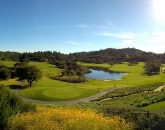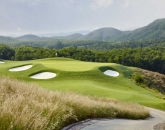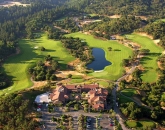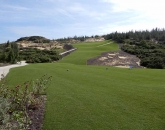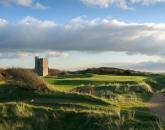 Open for Sure
Open for Sure
By 1933, the course was definitely open for play, as evidenced by this passage from an English-language brochure published that year: “The Lang-Biang Palace and the Grand Hotel de Dalat…offer every modern comfort, and diversion, including concerts, tennis, golf, walking tours and motor excursions.” (For more, see ‘From Indochine to Indochic: The Lang Bian/Dalat Palace Hotel and French Colonial Leisure, Power and Culture,’ by Eric T. Jennings in Modern Asian Studies 37, 1 (2003), 2003, p. 179.)
At that time, another course opened for play in Vietnam, the Go Vap Golf Course (a.k.a. Saigon Golf Club). This course dates to the tenure of Governor-General Pierre Pasquier (1928 - 1934) as evidenced by this entry from a National Geographic article in October 1935: “The late Governor-General Pasquier drove the first ball on a new golf course and aviation flourishes in Saigon.” It’s no surprise that National Geographic coupled golf and aviation since the old course was situated close to Tan Son Nhat Airport.
Whatever his involvement in the course’s development, Bao Dai’s love for the game of golf is certain. He enjoyed vacationing at several royal villas in Dalat, partly for proximity to Vietnam’s big game and partly, we can assume, for the proximity to the Dalat Golf Club. Today, Bao Dai’s clubs are on display in his former villa near the end of Trieu Viet Vuong Street.
Restoration in the 1950s
At the time of Bao Dai’s abdication in 1945, the course at Dalat was abandoned. Local vegetation overwhelmed the greens and fairways so thoroughly that when the course was revived, in the late 1950s, the layout’s savior, a medical doctor named Dao Huy Hach, had to rely on aerial photos from the National Geographical Institute to pick out the putting surfaces.
Dr. Hach had started to play golf at the Saigon Golf Club in the mid 1950s when Hoa Van Nguyen, architect of the Caravelle Hotel in Saigon, served as president of the Saigon Club. For Saigon players, golf in mile-high Dalat was the anti-dote to the year-round swelter of golf in the city.
The Saigon Golf Club funded most of the restoration, but there were numerous pro bono services offered by Dalat Golf Club members. The government also contributed money towards the construction of greens. In addition, members paid a 4,000VND (US$23) initiation fee and 600VND (US$4) monthly fee. There were about 40 members through the 1960s, most from the embassy staffs and foreign construction companies in the area.
The restoration of the course continued for nearly 15 years, as Dr. Hach drew on the assistance of the Saigon Golf Club, Japanese construction companies, and other members of the Dalat Golf Club to re-establish the original nine holes and begin construction of a second nine. Dr. Hach received assistance from the USGA for the second nine, including guidance on construction of greens, at no charge. In all, Dr. Hach estimated it cost about 3 million VND (about US$17,000) to bring back the course and clubhouse.
The clubhouse, itself, was and is a Le Tourquet style villa, with Tudor detailings that evoke golf’s roots in the British Isles. The villa is one of hundreds that the French built in Dalat throughout the 1930s and 1940s. Still, for all of the clubhouse’s visual appeal, it was a rustic affair for Dalat’s second generation of golfers.
“It was not to international standards,” said Dr. Hach. “It was like a garage: no power, no landscaping, no water. I had to bring all of that in.”
In 1959, Dr. Hach added a ninth hole to the original 8-hole layout in Dalat. Six years later, these nine holes were open for play — with a sand and motor oil mix standing in for grass on the greens — and Dr. Hach was contemplating another nine holes. A war got in the way.
Pages
Click here to see the published article.


